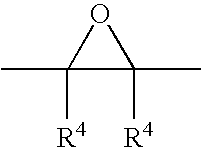Polymer composites containing nanotubes
a technology of carbon nanotubes and composite materials, which is applied in the field of polymer composite materials containing carbon nanotubes, can solve the problems of inability to homogeneously or uniformly disperse, in the polymer precursor or in the polymer itself, and inability to readily dissolve in solvents, so as to enhance the mechanical properties of composite materials containing m-phenylenevinylene-2,5-disubstituted p-phenylenevinylene,
- Summary
- Abstract
- Description
- Claims
- Application Information
AI Technical Summary
Benefits of technology
Problems solved by technology
Method used
Image
Examples
example 1
Synthetic Reactions for Preparation of Alkene-Substituted m-phenylenevinylene-2,5-disubstituted-p-phenylenevinylene (See Scheme 1)
Reaction Forming the Step 1 Product
[0084]The reaction is carried out by adding two equivalents of 8-bromo-1-octene along with one equivalent of hydroquinone to a 3-neck round bottom flask (RBF). To this is added 10 mL of DMF for each gram of hydroquinone used. This solution is heated to 60 EC using an oil bath, and stirred using a magnetic stir bar and stirrer. When the temperature reaches 60° C., a vacuum is applied to the reaction flask to remove any O2 from the reacting reagents and then the flask is flushed with argon. This is done 3 or 4 times. The reaction solution at this stage is clear and colorless. While the reaction flask is being flushed with argon to prevent oxygen from entering, powdered KOH (2 equivalents) is added to the flask via a funnel. The funnel is then rinsed with a small amount of DMF. Upon addition of KOH, the reaction mixture tur...
example 2
Purification of Carbon Nanotubes
[0104]Commerically available carbon nanotubes (CarboLex AP grade) may contain graphite and metal catalytst impurities. Graphite impuriteis may be burned-off employing methods such as that described by Eklund. CarboLex carbon nanotubes are made using the arc-discharge method and may contain Ni / Y catalyst impurities that are used in making the nanotubes. A procedure similar to one reported by Eklund can be used to remove these impurities.
[0105]In a 50 mL round bottom flask, 30 ml of 4M HCl was added over carbon nanotubes. The flask was equipped with a condenser and a stir bar and placed in an oil bath. The condenser was closed with a septa at the top. While the reaction mixture was heated a needle was put in the septa to prevent pressure accumulation. When the reaction mixture reached a temperature of about 95° C., the solution became black / gray and contained suspended particles. When stirring was stopped these particles settled to the bottom and sides ...
example 3
Making the m-phenylenevinylene-2,5-disubstituted-p-phenylenevinylene / SWNT Mixture
[0109]To make the m-phenylenevinylene-2,5-disubstituted-p-phenylenevinylene / SWNT composite, m-phenylenevinylene-2,5-disubstituted-p-phenylenevinylene, usually around the same weight as the weight of SWNTs to be used, is dissolved in toluene. SWNTs are added to this solution and then it is sonicated in an sonic bath for around an hour to obtain a uniform dispersion. If purified nanotubes are used, less time is needed to get a uniform dispersion of the nanotubes. Typical amounts used are 10 mL of toluene, 0.20 g of m-phenylenevinylene-2,5-disubstituted-p-phenylenevinylene and 0.20 g of SWNT. The toluene is then removed from this mixture and the m-phenylenevinylene-2,5-disubstituted-p-phenylenevinylene / SWNT mixture is dispersed in dichloromethane. The m-phenylenevinylene-2,5-disubstituted-p-phenylenevinylene / SWNT mixture can be dispersed in other solvents as needed. The solvent m-phenylenevinylene-2,5-disu...
PUM
| Property | Measurement | Unit |
|---|---|---|
| Mechanical strength | aaaaa | aaaaa |
| Electrical conductivity | aaaaa | aaaaa |
| Structure | aaaaa | aaaaa |
Abstract
Description
Claims
Application Information
 Login to View More
Login to View More - R&D
- Intellectual Property
- Life Sciences
- Materials
- Tech Scout
- Unparalleled Data Quality
- Higher Quality Content
- 60% Fewer Hallucinations
Browse by: Latest US Patents, China's latest patents, Technical Efficacy Thesaurus, Application Domain, Technology Topic, Popular Technical Reports.
© 2025 PatSnap. All rights reserved.Legal|Privacy policy|Modern Slavery Act Transparency Statement|Sitemap|About US| Contact US: help@patsnap.com



